| MAIN JEWISH HOLIDAYS | |
| SHABBAT :: ROSH HASHANNAH :: JOM KIPPUR :: PESAH :: PURIM :: HANNUKAH :: TU BISHVAT | |
|
In many ways halakha (Jewish law) gives Shabbat the status of being the most important holy day in the Jewish calendar. It is the first holiday mentioned in the Tanakh (Hebrew Bible), and God was the first one to observe it. The liturgy treats Shabbat as a bride and queen. The Torah reading on Shabbat has more sections of parshiot (Torah readings) than on Yom Kippur, the most of any Jewish holiday. There is a tradition that the Messiah will come if every Jew observes Shabbat perfectly twice in a row. Erev Purim and Fast of Esther known as "Ta'anit Ester" — 13 Adar In leap years on the Hebrew calendar, Purim is observed in the Second Adar (Adar Sheni).
Erev Hanukkah — 24 Kislev
Hanukkah marks the defeat of Seleucid Empire forces that had tried to prevent the people of Israel from practicing Judaism. Judah Maccabee and his brothers destroyed overwhelming forces, and rededicated the Temple in Jerusalem. The eight-day festival is marked by the kindling of lights — one on the first night, two on the second, and so on — using a special candle holder called a Chanukkiyah, or a Hanukkah menorah. There is a custom to give children money,also known as "gelt" on Hanukkah to commemorate the learning of Torah in guise of Jews gathering in what was perceived as gambling at that time since Torah was forbidden. Because of this, there is also the custom to play with the dreidel (called a sevivon in Hebrew). Erev Pesach and Fast of the Firstborn known as "Ta'anit Bechorim" — 14 Nisan The "Last days of Passover", known as Acharon shel Pesach, are also a holiday commemorating K'riat Yam Suf, the Passage of the Red Sea. — 21 and 22 Nisan
|
According to oral tradition, Rosh Hashanah is the Jewish new year, day of memorial and the day of judgment, in which God judges each person individually according to their deeds, and makes a decree for the following year. The holiday is characterized by the special mitzvah of blowing the shofar. According to the Torah, however, this is the first day of the seventh month of the calendar year that marks the beginning of a ten day count to Yom Kippur.
According to an opinion in Jewish oral tradition, the creation of the world was completed on Rosh Hashanah. The recitation of Tashlikh occurs during the afternoon of the first day. Officially North American Reform Judaism celebrates two days of Rosh Hashanah,[2] but a significant number of Reform congregations and members celebrate only one day; the non-Reform branches of Judaism celebrate it as a two-day holiday, both inside and outside the boundaries of Israel. The two days are considered together to be a yoma arichta, a single "long day". Erev Yom Kippur — 9 Tishrei
A traditional Aramaic prayer called Kol Nidre ("All Vows") is traditionally recited just before sunset. Although often regarded as the start of the Yom Kippur evening service - to such a degree that Erev Yom Kippur ("Yom Kippur Evening") is often called "Kol Nidre" (also spelled "Kol Nidrei") - it is technically a separate tradition. This is especially so because, being recited before sunset, it is actually recited on 9 Tishri, which is the day before Yom Kippur; it is not recited on Yom Kippur itself (on 10 Tishri, which begins after the sun sets). The words of Kol Nidre differ slightly between Ashkenazic and Sephardic traditions. In both, the supplicant prays to be released from all personal vows made to God during the year, so that any unfulfilled promises made to God will be annulled and, thus, forgiven. In Ashkenazi tradition, the reference is to the coming year; in Sephardic tradition, the reference is to the year just ended. Only vows between the supplicant and God are relevant. Vows made between the supplicant and other people remain perfectly valid, since they are unaffected by the prayer. Yom Kippur is considered, along with 15th of Av, as the Happiest days of the year (Talmud Bavli - Tractate Ta'anit). Tu Bishvat (חג האילנות - ט"ו בשבט) — 15 Shevat
Traditionally, trees are planted on this day. Many children collect funds leading up to this day to plant trees in Israel. Trees are usually planted locally as well. |





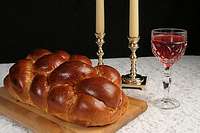 Jewish law accords Shabbat the status of a holiday, a day of rest celebrated on the seventh day of each week. Jewish law defines a day as ending at nightfall, which is when the next day then begins. Thus, Shabbat begins at sundown Friday night, and ends at nightfall Saturday night.
Jewish law accords Shabbat the status of a holiday, a day of rest celebrated on the seventh day of each week. Jewish law defines a day as ending at nightfall, which is when the next day then begins. Thus, Shabbat begins at sundown Friday night, and ends at nightfall Saturday night.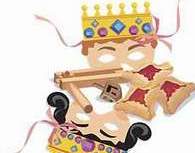 Purim commemorates the events that took place in the Book of Esther. It is celebrated by reading or acting out the story of Esther, and by making disparaging noises at every mention of Haman's name. In Purim it is a tradition to masquerade around in costumes and to give Mishloakh Manot (care packages, i.e. gifts of food and drink) to the poor and the needy. In Israel it is also a tradition to arrange festive parades, known as Ad-D'lo-Yada, in the town's main street. Sometimes the children dress up and act out the story of Esther for their parents.
Purim commemorates the events that took place in the Book of Esther. It is celebrated by reading or acting out the story of Esther, and by making disparaging noises at every mention of Haman's name. In Purim it is a tradition to masquerade around in costumes and to give Mishloakh Manot (care packages, i.e. gifts of food and drink) to the poor and the needy. In Israel it is also a tradition to arrange festive parades, known as Ad-D'lo-Yada, in the town's main street. Sometimes the children dress up and act out the story of Esther for their parents.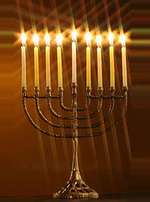 The story of Hanukkah is preserved in the books of the First and Second Maccabees. These books are not part of the Tanakh (Hebrew Bible), they are apocryphal books instead. The miracle of the one-day supply of oil miraculously lasting eight days is first described in the Talmud.
The story of Hanukkah is preserved in the books of the First and Second Maccabees. These books are not part of the Tanakh (Hebrew Bible), they are apocryphal books instead. The miracle of the one-day supply of oil miraculously lasting eight days is first described in the Talmud.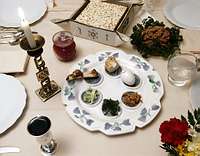 Passover commemorates the liberation of the Israelite slaves from Egypt. No leavened food is eaten during the week of Pesach, in commemoration of the fact that the Jews left Egypt so quickly that their bread did not have enough time to rise.
Passover commemorates the liberation of the Israelite slaves from Egypt. No leavened food is eaten during the week of Pesach, in commemoration of the fact that the Jews left Egypt so quickly that their bread did not have enough time to rise.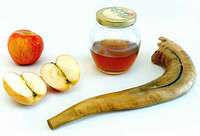 Rosh Hashanah is set aside by the Mishna as the new year for calculating calendar years, shmita and jubilee years, vegetable tithes, and tree-planting (determining the age of a tree). Example of Jewish Calendar.
Rosh Hashanah is set aside by the Mishna as the new year for calculating calendar years, shmita and jubilee years, vegetable tithes, and tree-planting (determining the age of a tree). Example of Jewish Calendar. Yom Kippur is the holiest day of the year for most Jews (Karaite Jews regard Passover as the holiest day of the year, as do Samaritans). Its central theme is atonement and reconciliation. This is accomplished through prayer and complete fasting - including abstinence from all food and drink (including water), unless fasting is prohibited for medical reasons (e.g., Jewish law does not permit fasting by nursing mothers, diabetics, people with anorexia nervosa, etc.). Bathing, wearing of perfume or cologne, wearing of leather shoes, and sexual relations are some of the other prohibitions on Yom Kippur - all them designed to ensure one's attention is completely and absolutely focused on the quest for atonement with God. The fast and other prohibitions commence on 10 Tishri at sunset - sunset being the beginning of the day in Jewish tradition.
Yom Kippur is the holiest day of the year for most Jews (Karaite Jews regard Passover as the holiest day of the year, as do Samaritans). Its central theme is atonement and reconciliation. This is accomplished through prayer and complete fasting - including abstinence from all food and drink (including water), unless fasting is prohibited for medical reasons (e.g., Jewish law does not permit fasting by nursing mothers, diabetics, people with anorexia nervosa, etc.). Bathing, wearing of perfume or cologne, wearing of leather shoes, and sexual relations are some of the other prohibitions on Yom Kippur - all them designed to ensure one's attention is completely and absolutely focused on the quest for atonement with God. The fast and other prohibitions commence on 10 Tishri at sunset - sunset being the beginning of the day in Jewish tradition. Tu Bishvat is the new year for trees. According to the Mishnah, it marks the day from which fruit tithes are counted each year, and marks the timepoint from which the Biblical prohibition on eating the first three years of fruit and the requirement to bring the fourth year fruit to the Temple in Jerusalem were counted. In modern times, it is celebrated by eating various fruits and nuts associated with the Land of Israel. During the 17th century, Rabbi Yitzchak Luria of Safed and his disciples created a short seder, called Hemdat ha‑Yamim, reminiscent of the seder that Jews observe on Passover, that explores the holiday's Kabbalistic themes.
Tu Bishvat is the new year for trees. According to the Mishnah, it marks the day from which fruit tithes are counted each year, and marks the timepoint from which the Biblical prohibition on eating the first three years of fruit and the requirement to bring the fourth year fruit to the Temple in Jerusalem were counted. In modern times, it is celebrated by eating various fruits and nuts associated with the Land of Israel. During the 17th century, Rabbi Yitzchak Luria of Safed and his disciples created a short seder, called Hemdat ha‑Yamim, reminiscent of the seder that Jews observe on Passover, that explores the holiday's Kabbalistic themes.